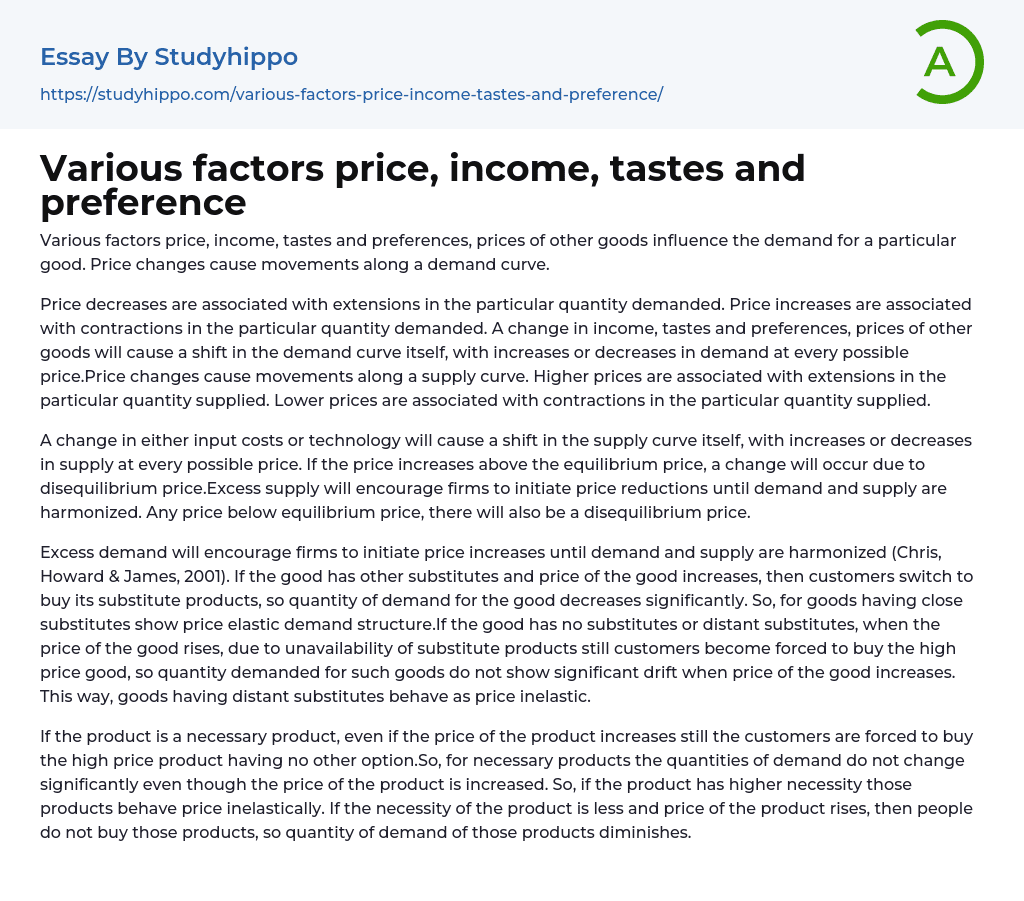

Various factors price, income, tastes and preference Essay Example
The demand for a specific good is influenced by various factors such as price, income, tastes and preferences, and the prices of other goods. Changes in price result in movements along the demand curve.
The relationship between price changes and quantity demanded is straightforward. If the price decreases, the quantity demanded increases, and if the price increases, the quantity demanded decreases. However, external factors such as shifts in income levels, preferences, and prices of other goods can cause a shift in the entire demand curve. This means that at any given price, demand can either increase or decrease.
On the other hand, price changes have an impact on movements along the supply curve. When prices increase, the quantity supplied also increases; whereas lower prices lead to a decrease in quantity supplied. Similar to demand, various factors like input costs and technol
...ogy can result in a shift in the supply curve itself, leading to an overall increase or decrease in supply at any possible price.
If the price exceeds the equilibrium level, it will cause a disequilibrium and lead to an excess supply. Firms will lower prices until demand and supply reach a balance. Conversely, if the price falls below the equilibrium level, another disequilibrium occurs. Excess demand will cause firms to increase prices until demand and supply are balanced (Chris, Howard & James, 2001).
When the price of a good with substitutes rises, customers tend to switch their purchases to substitute products, resulting in a notable decrease in demand for that specific good. Therefore, goods with close substitutes demonstrate price elastic demand.
In cases where a good has no or distant substitutes available, even if its price increases, customers still have t
buy it because substitute products are not available. As a result, the quantity demanded for such goods does not significantly change when their price increases.
This way, goods with distant substitutes are considered price inelastic. Even if the price of a necessary product increases, customers are forced to purchase it without any alternative options. Therefore, the demand for necessary products does not change significantly when the price is increased. Consequently, products with high necessity exhibit price inelasticity. However, if the necessity of a product is lower and its price increases, people do not buy it, leading to a decrease in demand. Hence, products with lower necessity display price elasticity.
References
- Mulhearn, C., Vane, H. R. & Eden, J. (2001) Economics for business. Hampshire, New York: Palgrave Publishers Ltd.
- Advertising essays
- Audience Theory essays
- Competitor Analysis essays
- Consumer essays
- Marketing Management essays
- Marketing Mix essays
- Marketing Plan essays
- Marketing Research essays
- Marketing Strategy essays
- Point Of Sale essays
- Price essays
- Procurement essays
- Product essays
- Product Differentiation essays
- Promotion essays
- Promotion And Marketing Communications essays
- Retailing essays
- Trademark essays
- Anheuser-busch essays
- Brands essays
- Detergent essays
- Product Placement essays
- Research Design essays
- New Product Development essays
- Advertisement essays
- Brand essays
- Sales Promotion essays
- Advertising campaign essays
- Consumer behaviour essays
- Offer And Acceptance essays
- Wal-Mart essays
- Discover essays
- Accounting essays
- Andrew Carnegie essays
- Automation essays
- Business Cycle essays
- Business Intelligence essays
- Business Model essays
- Business Operations essays
- Business Software essays
- Cooperation essays
- Cooperative essays
- Corporate Social Responsibility essays
- Corporation essays
- Customer Relationship Management essays
- Family Business essays
- Franchising essays
- Harvard Business School essays
- Harvard university essays
- Human Resource Management essays



